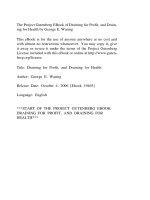Nanotechnology for Biology and Medicine docx
Bạn đang xem bản rút gọn của tài liệu. Xem và tải ngay bản đầy đủ của tài liệu tại đây (6.78 MB, 251 trang )
FUNDAMENTAL BIOMEDICAL TECHNOLOGIES
Series Editor:
Mauro Ferrari, Ph.D. Houston, TX
For further volumes:
/>
Gabriel A. Silva
●
Vladimir Parpura
Editors
Nanotechnology
for Biology and Medicine
At the Building Block Level
Editors
Gabriel A. Silva
Departments of Bioengineering
and Ophthalmology
and Neurosciences Program
University of California
San Diego, CA, USA
Vladimir Parpura
Department of Neurobiology
Atomic Force Microscopy
& Nanotechnology Laboratories
Center for Glial Biology in Medicine
Civitan International Research Center
Evelyn F. McKnight Brain Institute
University of Alabama
Birmingham, AL, USA
ISSN 1559-7083
ISBN 978-0-387-31282-8 e-ISBN 978-0-387-31296-5
DOI 10.1007/978-0-387-31296-5
Springer New York Dordrecht Heidelberg London
Library of Congress Control Number: 2011935360
© Springer Science+Business Media, LLC 2012
All rights reserved. This work may not be translated or copied in whole or in part without the written
permission of the publisher (Springer Science+Business Media, LLC, 233 Spring Street, New York,
NY 10013, USA), except for brief excerpts in connection with reviews or scholarly analysis. Use in
connection with any form of information storage and retrieval, electronic adaptation, computer software,
or by similar or dissimilar methodology now known or hereafter developed is forbidden.
The use in this publication of trade names, trademarks, service marks, and similar terms, even if they are
not identifi ed as such, is not to be taken as an expression of opinion as to whether or not they are subject
to proprietary rights.
Printed on acid-free paper
Springer is part of Springer Science+Business Media (www.springer.com)
To Monica, Katie, and Jason
Gabriel A. Silva
To Vedrana, Vuga, and Ivan
Vladimir Parpura
vii
Only within the last few years has much of the vision of Richard Feynman’s now
famous lecture on December 29
th
, 1959 at the American Physical Society meeting
held at the California Institute of Technology, “There’s plenty of room at the bottom,”
been realized. To a signifi cant degree, this has been due to the relatively recent
advances in chemistry, physics, materials science, and engineering that needed to
precede the development of the kinds of technologies and applications Feynman
eluded to in his talk. Designing, modeling, understanding, and ultimately building
nanotechnologies is not an easy pursuit. Roughly speaking, nanotechnologies are
engineered technologies and devices made up of materials and components over
which some spatial aspect of the technology has been purposely designed and engi-
neered at a nanoscale, typically regarded as between 1 and 100 nm or so. Importantly,
the technology must exhibit some property or behavior or ability to interact with its
environment that is unique and novel to the engineered device that is not a property
of the constituent building block materials or elements. It is these properties from
which the potential of nanotechnology stems. The scale at which such technologies
are able to interact with their environment in order to produce unique and novel
macroscopic effects is unprecedented.
Arguably one of the most important areas of application for nanotechnology is in
biology and medicine. This is largely due to the vast complexity, both in structure
and function, of biological systems, which makes developing technologies that can
interface, sense, and respond to such systems diffi cult to design and engineer. In
many ways, we know so little still about such systems that it is unclear how best to
develop approaches and technologies to interact with them. Even in cases where
the molecular and cellular details are understood for the most part, the correct mate-
rials, approaches, and methods to optimize such interactions are never clear cut.
The potential of nanotechnology to accomplish such interactions results from
the scale at which such technologies are designed relative to the fundamental func-
tional scales at which cells operate. Most of the physical and chemical interactions
between nanotechnologies and cells occur at the fundamental building molecular
scale block level from which cells are made up. This ability translates into controlled
interactions at a scale at which basic cell processes and functions are taking place,
Preface
viii
Preface
which ultimately translate up scales of organization to affect processes and func-
tions at the tissue, organ, organ system, and ultimately organism levels. Thus, in
theory, manipulations of materials and the design and engineering of devices at near
atomic scales, in part the realization of Feynman’s seminal lecture, should ulti-
mately be able to accomplish these ideals and result in technologies that truly could,
by design, interact with biological systems at fundamental building block scales.
The result of such work will be spectacular, producing novel ways of measuring and
studying biological systems in order to gain insights and understanding not possible
with current technologies, and the development of technologies and methods for
practical applications and uses, such as completely new ways to diagnose and treat
diseases.
In practice though, much work remains to be done for such research to translate
into viable experimental and clinical applications. As mentioned above, going from
theory to practice is diffi cult. There are very few areas of modern science that are as
truly interdisciplinary as nanotechnology and nanoengineering. The design, devel-
opment, and eventual use of such technologies require the participation and coordi-
nation of individuals with different types of training and expertise. No one person
has enough PhDs to cover every aspect of a nanotechnology project from start to
fi nish. Given the proliferation of research centers, institutes, in some cases even
departments in nanotechnology and nanoengineering, many students are now pur-
suing graduate degrees in nanotechnology. Despite this, their expertise will inevita-
bly focus on one or a few areas, usually in the design and synthesis aspects. This
means that no matter how one is trained, nanotechnology demands the input and
participation of different individuals. This results in an interesting scientifi c socio-
logical phenomenon: Very different scientifi c cultures and languages need to work
together in order to accomplish meaningful high impact work. While this is true of
any interdisciplinary pursuit, it is especially true and challenging for nanotechnol-
ogy because it crosses so many basic and applied fi elds, all of them essential to the
fi nal result. For applications to biology and medicine, this means that biologists and
clinicians from different disciplines need to be able to communicate and work with
physical scientists. While it seems like a straightforward and obvious statement,
anyone who has tried it knows how diffi cult it really is. Different disciplines have
different values and a sense of what details are important, read different journals and
attend different conferences, and individuals have different levels of understanding
of areas outside of their comfort zone of expertise. Nonetheless, while challenging,
it is all very doable, and in recent years we have seen some amazing advances from
such collaborations, in particular, in areas of biology and medicine. Still, much of
the work to date in the literature is still at the “proof of concept” stages. Very few
applications have reached maturity. A colleague recently pointed out with some
exasperation to one of us how it seems like the number of review articles populating
the literature far exceeds the actual number of truly high impact primary research
papers. In other words, while the potential for nanotechnology to have a high impact
on biological, including biomedical research, and clinical medicine is very signifi -
cant, very little to date has actually achieved such impact. This is not a negative,
ix
Preface
however, but an opportunity. Much of the research coming over the horizon seems
truly spectacular, and we anticipate that the next few years will live up to this.
For example, in our specifi c area of interest, which is the application of nano-
technology to neuroscience, these methods and technology offer tremendous oppor-
tunities for new ways to measure and observe brain function at cellular and
subcellular, i.e., molecular, scales. This in turn should allow us to understand neural
dynamics and physiology in completely new ways, ultimately informing us about
how the brain works under normal conditions and how it fails in cases of disease.
Many of these nanotechnology methods for studying brain function are comple-
mentary to other emerging methods in neuroscience, such as genetic methods,
although little has been done toward integrating them so far. In parallel, other
approaches are focused on diagnostic and therapeutic targets that make use of nano-
technology. Many neurological disorders are multidimensional and mechanistically
complex, and current therapeutic standards detect changes simply too late in the
disease process for therapies to have signifi cant effects. Similarly, given the com-
plexity of neurological disorders, nanotechnologies provide the opportunity to per-
form different necessary functions in specifi c sequences: for example, crossing the
blood brain barrier, targeting a cell population, and then delivering a therapeutic
payload.
The contributions in this book have been written by some of the pioneers in the
development and application of nanotechnology to biology and medicine. They are
intended to provide the reader with an appreciation for and an understanding of the
biological (i.e., molecular, cellular, and physiological) key challenges in this pur-
suit, as well as an understanding of the approaches and strategies being developed
by cutting edge research to address such challenges. It is a refl ection of and testa-
ment to the amount of progress that has occurred in an incredibly short period of
time comparative to the long history of science, but it is also meant to give a realistic
picture of the open problems and challenges that need to be resolved. In the process,
though, we hope that different chapters will motivate and capture the imagination of
the reader. Much work remains.
La Jolla, CA Gabriel A. Silva
Birmingham, AL Vladimir Parpura
xi
We would like to thank Diane Yu for her assistance. We thank all the authors for
their contributions. This book would not exist without them.
Acknowledgments
xiii
Part I Nanoscale Processes in Cells
Structure and Biology of the Cellular Environment:
The Extracellular Matrix 3
Igor Titushkin, Shan Sun, and Michael Cho
Part II Synthesis and Characterization Approaches
Synthesis and Patterning Methods for Nanostructures
Useful for Biological Applications 27
Chiara Daraio and Sungho Jin
Characterization of Nanoscale Biological Systems: Multimodal
Atomic Force Microscopy for Nanoimaging, Nanomechanics,
and Biomolecular Interactions 45
Arjan P. Quist and Ratnesh Lal
Part III Nanobiotechnology: Biologically Inspired Nanoengineering
and Their Applications
Molecular Motors and Machines 71
Serena Silvi and Alberto Credi
Micro and Nano Engineered Extracellular Matrices 101
James J. Norman and Tejal A. Desai
Designer Self-Assembling Peptide Nanofi ber Scaffolds 123
Shuguang Zhang, Hidenori Yokoi, Fabrizio Gelain, and Akihiro Horii
Contents
xiv
Contents
Part IV Nanomedicine: Nanotechnology for Diagnosis and Treatment
Quantum Dot Imaging of Neural Cells and Tissue 151
Tania Q. Vu and Sujata Sundara Rajan
Quantum Dot Methods for Cellular Neuroimaging 169
Gabriel A. Silva
Carbon Nanotubes as Electrical Interfaces to Neurons 187
Michele Giugliano, Luca Gambazzi, Laura Ballerini,
Maurizio Prato, and Stephane Campidelli
Carbon Nanotubes as Modulators of Neuronal Growth 209
Reno C. Reyes and Vladimir Parpura
Index 225
xv
Laura Ballerini Life Science Department , B.R.A.I.N., University of Trieste ,
Trieste , Italy
Stephane Campidelli Laboratoire d’Electronique Moléculaire,
CEA Saclay , Gif-sur-Yvette , France
Michael Cho Department of Bioengineering , University of Illinois at Chicago ,
Chicago , IL , USA
Alberto Credi Dipartimento di Chimica “G. Ciamician” ,
Università di Bologna , Bologna , Italy
Chiara Daraio Division of Engineering and Applied Science ,
California Institute of Technology , Pasadena , CA , USA
Tejal A. Desai Department of Bioengineering and Therapeutic Sciences ,
University of California , San Francisco , CA , USA
Luca Gambazzi Laboratory of Neural Microcircuitry , Brain Mind Institute,
École Polytechnique Fédérale de Lausanne , Lausanne , Switzerland
Fabrizio Gelain Center for Biomedical Engineering, Center for Bits & Atoms,
Massachusetts Institute of Technology , Cambridge , MA , USA
Michele Giugliano Laboratory of Neural Microcircuitry ,
Brain Mind Institute, École Polytechnique Fédérale de Lausanne ,
Lausanne , Switzerland
Department of Biomedical Sciences, University of Antwerp, Belgium
Akihiro Horii
Center for Biomedical Engineering, Center for Bits & Atoms,
Massachusetts Institute of Technology , Cambridge , MA , USA
Sungho Jin Materials Science & Engineering Program, Mechanical
and Aerospace Engineering Department , University of California , San Diego,
La Jolla , CA , USA
Contributors
xvi
Contributors
Ratnesh Lal Departments of Mechanical and Aerospace, and Bio-engineering ,
University of California, San Diego , La Jolla , CA , USA
James J. Norman Warner Babcock Institute for Green Chemistry, LLC ,
Wilmington , MA , USA
Vladimir Parpura Department of Neurobiology, Atomic Force Microscopy
& Nanotechnology Laboratories , Center for Glial Biology in Medicine,
Civitan International Research Center, Evelyn F. McKnight Brain Institute,
University of Alabama , Birmingham , AL , USA;
IKERBASQUE, Basque Foundation for Science, Bilbao, Spain;
School of Medicine, University of Split, Split, Croatia
Maurizio Prato Department of Pharmaceutical Sciences ,
University of Trieste , Trieste , Italy
Arjan P. Quist Richmond Chemical Corporation , Oak Brook , IL , USA
Sujata Sundara Rajan Department of Biomedical Engineering ,
Oregon Health & Sciences University , Portland , OR , USA
Reno C. Reyes Department of Neurobiology, Atomic Force Microscopy
& Nanotechnology Laboratories, Center for Glial Biology in Medicine,
Civitan International Research Center, Evelyn F. McKnight Brain Institute,
University of Alabama , Birmingham , AL , USA;
Department of Neurology , University of California,
San Francisco and Veterans Affairs Medical Center , San Francisco , CA , USA
Gabriel A. Silva Departments of Bioengineering and Ophthalmology
and Neurosciences Program , University of California , San Diego , CA , USA
Serena Silvi Dipartimento di Chimica “G. Ciamician” , Università di Bologna ,
Bologna , Italy
Shan Sun Department of Bioengineering , University of Illinois at Chicago ,
Chicago , IL , USA
Igor Titushkin Department of Bioengineering , University of Illinois
at Chicago , Chicago , IL , USA
Tania Q. Vu Department of Biomedical Engineering , Oregon Health
& Sciences University , Portland , OR , USA
Hidenori Yokoi Center for Biomedical Engineering, Center for Bits & Atoms,
Massachusetts Institute of Technology , Cambridge , MA , USA
Shuguang Zhang Center for Biomedical Engineering, Center for Bits & Atoms,
Massachusetts Institute of Technology , Cambridge , MA , USA
Part I
Nanoscale Processes in Cells
3
G.A. Silva and V. Parpura (eds.), Nanotechnology for Biology and Medicine:
At the Building Block Level, Fundamental Biomedical Technologies,
DOI 10.1007/978-0-387-31296-5_1, © Springer Science+Business Media, LLC 2012
1 Introduction
The extracellular matrix (ECM) represents a complex organization of macromol-
ecules that surrounds the cell and comprises the substratum onto which the cell
may be attached. The properties and functions of the ECM depend ultimately on
its structure, molecular components, architecture, and dynamic modulation.
Because the critical role of ECM involved in cell biology and physiology has long
been recognized, the structure and biology of the ECM have been extensively
studied (Yurchenco and Birk 1994 ; Ayad et al. 1998 ; Robert 2001 ) . The diversity
found in the structure and organization of the ECM appears to be tissue specifi c
and regulates the properties and function of each tissue. The ECM was once
believed to provide mainly the structural support and tensile strength of the tissue.
It is now recognized that in addition to the role of mechanical stability, the ECM
also provides substrate for cell adhesion and migration and regulates cell differen-
tiation, metabolic activity, and cell–cell signaling, and therefore intimately
involved in cellular and molecular response and behavior of the cell. For example,
the ECM is found to harbor potent signaling cues, such as cytokines and growth
factors (Engel 2004 ) . Furthermore, the relationship between cell and ECM can be
considered bidirectional (Cukierman et al. 2001 ; Geiger et al. 2001 ; Labat-Robert
2004 ; Yoon et al. 2005 ) : while ECM is known to infl uence the cell behaviors and
functions, the cell, in turn, modifi es local environment and remodels the ECM.
This ability of ECM to undergo remodeling plays an important role especially in
developmental tissue (Zagris 2001 ; Trelstad 2004 ) and wound healing (Schaffer
and Nanney 1996 ; Tuan et al. 1996 ; Cutroneo 2003 ) . In the context of tissue
Structure and Biology of the Cellular
Environment: The Extracellular Matrix
Igor Titushkin, Shan Sun, and Michael Cho
I. Titushkin • S. Sun • M. Cho (
)
Department of Bioengineering , University of Illinois at Chicago ,
851 S. Morgan St. (M/C 063) , Chicago , IL 60607 , USA
e-mail:
4 I. Titushkin et al.
engineering, elucidation of the ECM structure and biology also has a rather critical
implication. Dynamic interactions between ECM and cell must be characterized
and understood at the molecular level for desired manipulation of the ECM that
lead to successful tissue-engineering applications. Congruent with the current
research emphasis on nanotechnology, tissue-engineering methodologies will
likely be refi ned and improved by replication of the complex features of natural
ECM at the micro- and nanoscale.
2 Composition and Architecture of ECM
2.1 Major ECM Molecules
The composition of the ECM may be classifi ed into at least fi ve major categories
of components. Molecules found in the ECM include (1) structural proteins, such
as collagen and elastin; (2) adhesion proteins, such as fi bronectin and laminin; (3)
soluble growth factors and cytokines; (4) proteoglycans; and (5) tissue-specifi c
molecules. First, collagen, with at least known 21 subtypes in its family, is the
major protein that comprises the ECM. Each type-I collagen molecule, for
instance, contains three chains (called a chains) twisted around each other to form
a triple helix, and lateral interactions of triple helices of collagens result in the
formation of fi brils roughly 10–300 nm diameter and up to hundreds of micron
length in mature tissues (Alberts et al. 2002 ) . The triple helix gives the collagen a
rigid structure that maintains the mechanical and structural integrity of tissues.
There exist several different a chains that are found in various combinations in
the collagen subtypes. Second, fi bronectin, the next largest quantity of proteins
found in the ECM, is one of the glycoproteins involved in cell adhesion to the
ECM and cell migration. It exists as a dimer composed of two very large subunits
joined by a pair of disulfi de bonds near the carboxyl termini (Alberts et al. 2002 ) .
Each subunit is folded into a series of functionally distinct domains separated by
regions of fl exible polypeptide chains 60–70-nm long and 2–3-nm thick. Third,
growth factors and cytokines are the examples of signaling proteins solubilized in
the ECM that can stimulate cells to grow, migrate, and mediate cell–cell commu-
nications (Perris and Perissinotto 2000 ; Brownlee 2002 ; Kleinman et al. 2003 ) .
These generally small signaling molecules can infl uence the cell by binding to a
receptor expressed on the cell surface and activate the receptor-mediated signaling
transduction cascades. Fourth, macromolecules found in the ECM include proteo-
glycans and glycosaminoglycan (GAG). Proteoglycans consist of one or more GAG
chains attached to a core protein. Unlike glycoproteins with one or more oligosac-
charide chains covalently bound to amino acid side chains, proteoglycans contain
much more carbohydrate by weight, mostly in the form of long, unbranched, GAG
chains rather than short, branched, oligosaccharide chains found in glycoproteins
(Alberts et al. 2002 ) . Proteoglycans are thought to play a key role in chemical
5
Structure and Biology of the Cellular Environment: The Extracellular Matrix
signaling between cells, and regulate the activities of secreted proteins, such as
growth factors. Some of the plasma membrane proteoglycans can bind cells to the
ECM and trigger the responses of cells to extracellular signals (Simons and
Horowitz 2001 ; Yoneda and Couchman 2003 ) . GAG is an unbranched, negatively
charged, polysaccharide chain composed by repeating disaccharide units. The
main groups of GAGs of physiological signifi cance are hyaluronic acid (hyaluro-
nan), chondroitin sulfate, dermatan sulfate, heparan sulfate, and keratan sulfate.
Hyaluronan is unique among the GAGs because it does not contain any sulfate
and is a component of non-covalently formed complexes with proteoglycans in
the ECM. Hyaluronic acid polymers are very large (with molecular weights of
100–10,000 kDa) and can occupy a large volume. GAGs are located either in the
ECM or on the surface of cells, where these molecules serve as coreceptors to
help cells respond to secreted signal proteins (Raman et al. 2005 ) . Due to high
viscosity and low compressibility, the mechanical characteristics of GAG are
ideal for excellent lubricators and shock absorbers and used as a lubricating fl uid,
for example, in the joints. Finally, examples of the tissue-specifi c components
include aggregans in the cartilage tissue or minerals (e.g., hydroxyapatite) in the
bone tissue.
2.2 ECM Architecture
Similar architectural characteristics of ECM can be found in the major tissue types,
such as nerve, muscle, epithelial, and connective tissues. Generally, the ECM is
made of various protein fi bers interwoven in a hydrated gel composed of proteogly-
cans and GAG chains (Fig. 1 ). Fibrillar collagen forms the major matrix, strength-
ens the scaffold, and also provides substratum for cell adhesion. GAGs fi ll a large
volume and form highly hydrated gels in ECM. Adhesion proteins in the matrix and
on the surface of cell membrane bind macromolecules and cells to build up ECM
into an active and dynamic organization that can infl uence the cellular cytoskeleton
and cell spreading. The diversity of ECM in different tissues arises from the relative
amounts of the macromolecules mentioned above, tissue-specifi c components, and
the way in which they are arranged. For example, connective tissue and epithelial
tissue represent two extremes of contrasting spatial organization. In connective tis-
sue, cells are sparsely distributed within the ECM. Direct attachments between cells
are relatively rare, and the ECM is rich in fi brous polymers, especially collagens,
which bear most of the mechanical stress the tissue is subjected to. In contrast, epi-
thelial tissue has a scant ECM, consisting mainly of a thin mat called the basal
lamina, which underlies the epithelium. Cells are tightly bound together into sheets
called epithelia. The cells are attached to each other by cell–cell adhesions that bear
most of the mechanical stresses. Strong intracellular protein fi laments connect the
cells either to each other or to the underlying basal lamina. Examples would include
capillaries that consist of a single layer of endothelial cells attached to a basal
6 I. Titushkin et al.
lamina and every smooth muscle that is attached to its neighboring muscle cells by
a basal lamina.
2.3 ECM–Cell Communication Pathways
Bidirectional communication between ECM and cell is likely mediated by a family
of transmembrane adhesion proteins that are referred to as integrins, which act as
receptors and bind to the ECM components, including collagen and fi bronectin
(Heino 2000 ; Farias et al. 2005 ) . An integrin molecule has two non-covalently asso-
ciated transmembrane glycoprotein subunits called a and b chains with their globu-
lar heads projecting more than 20 nm from the lipid bilayer (Smith 1994 ) . As this
end of integrin binds the ECM with different specifi city and relatively low affi nity,
the other end of integrin binds to actin cytoskeleton inside the cell. This dual bind-
ing capacity is required to relate the molecular signals in and out of the cell (i.e.,
bidirectional communication), thus providing active intracellular signaling path-
ways for communications between the cell and ECM. A unique feature of the inte-
grin is found in its adhesive motif that was initially discovered by Pierschbacher
et al. ( 1981 ) . A 11-kDa fragment from fi bronectin was identifi ed to have the capac-
ity to support cell adhesion. Subsequent studies (Pierschbacher and Ruoslahti 1984 )
showed that this fragment can be mimicked by a small peptide containing the Arg–
Gly–Asp (RGD) sequence. In addition to fi bronectin, this adhesive motif is found in
other ECM proteins and blood adhesion proteins (Suzuki et al. 1985 ; Sadler et al.
1985 ) . Not all, but most of the subtypes of integrins recognize this particular adhe-
sive motif, and thus integrins can bind to the major ECM proteins (fi bronectin, col-
lagen, laminin, vitronectin, to name just a few) and mediate the receptor–ligand
binding interactions.
Fig. 1 Schematic cartoon for ECM molecules and architectural arrangement
7
Structure and Biology of the Cellular Environment: The Extracellular Matrix
3 Role of ECM in Tissue Development and Wound Healing
3.1 Expression of ECM in the Biological Process of Tissue
Development
In tissue development, the ECM molecules are known to direct cell attachment,
movement, and localize inductive signals. The development of ECM refl ects the
acquisition of differentiated functions of the cells. Newly produced ECM in turn,
via cell signaling, specifi es cell fate and regulates the formation of tissues and
morphogenesis of organs (Zagris 2001 ) . Improper regulation of ECM can result in
aberrant tissue development and diseases. Many ECM components appear only
transiently during specifi c developmental or pathological events (Svetlana 2004 ) .
For example, laminins, which are heterotrimeric glycoproteins in the basement
membrane, consist of multiple isoforms that vary in their chain composition and
tissue distribution during embryogenesis (De Arcangelis and Labouesse 2000 ) .
More signifi cantly, degradation and remodeling of the ECM are largely controlled
by matrix metalloproteinases (or metalloproteases; MMPs) and their specifi c tissue
inhibitors of metalloproteinases (TIMPs). Many MMPs [at least 20 subtypes identi-
fi ed (Jones et al. 2003 ) ] are expressed widely during embryogenesis, but not in adult
life. In adult life, MMPs are expressed in rapidly remodeling tissues, such as the
term placenta, menstrual endometrium, and involuting mammary glands, and dur-
ing wound healing. The expression of MMPs in organogenesis is intensively con-
trolled by growth factors and cytokines (Feinberg et al. 2000 ) . ECM molecules and
their receptors are essential in development, because they regulate many aspects in
tissue-specifi c development, such as cell growth and proliferation modulated by the
growth factors. During embryonic development of multicellular organisms, integ-
rins are the main family of cell-surface receptors that mediate cell–matrix interac-
tions and signaling pathway. This adhesion function of ECM has often been
mimicked in synthetic ECMs by fabricating the polymers to include the adhesive
motif (e.g., RGD peptides) and presenting them to the cell. While fi bronectin is
required for the mesoderm development (De Arcangelis and Labouesse 2000 ) , other
ECM proteins, such as laminins and collagens, play a particularly crucial role in
epithelial development, and the informational cues arising from ECM remodeling
are transmitted via intracellular signaling to effect epithelial gene expression.
3.2 ECM of Wound Healing
Similar to intricate dynamics of ECM remodeling during tissue development,
another excellent example of ECM remodeling is found in wound healing. It is a
complex process that involves different cell types and coordinated cellular activities
and reveals a multifunctional ECM role in normal and injured tissue metabolism.
For example, in skin wound repair, white cells, keratinocytes, fi broblasts, and
8 I. Titushkin et al.
endothelial cells all play a role in a well-established sequence of events that eventually
lead to repair of the damage tissue by remodeling ECM. In a schematic that divides
the wound healing into distinctive different stages (infl ammation, proliferation, and
remodeling; see Fig. 2 ), ECM remodeling in the wound begins as soon as a new
ECM is laid down. Different cell types play a key role at each stage and are regu-
lated by numerous growth factors and cytokines (Moore 2001 ) . The progression of
wound repair is frequently modeled in the skin, but parallel and temporally coordi-
nated events occur in most tissues following injury.
Wound healing
sequence
ECM contribution
Tissue injury
Disruption of native ECM architecture
Hemostasis and
inflammation
Blood exposure to collagen leads to platelet
activation, clotting cascade initiation
Fibrin network is major clot component, stops
bleeding, closes the wound.
Cell proliferation and
granulation tissue
formation
Proliferating fibroblast create provisional fiber
network of collagen, fibronectin, hyaluronic acid.
HA facilitates cell migration and stimulates
endothelial cell proliferation. Fibronectin is involved
in re-epithelization and serves as template for
collagen deposition.
Wound tissue maturation;
ECM synthesis and
reorganization
Initially randomly distributed collagen fibrils become
cross-linked, and aggregate into regularly organized
bundles oriented along the lines of stress in the
wound.Collagenases are involved in collagen
degradation and remodeling.
Wound contraction occurs as a result of an
interaction between fibroblast locomotion and
collagen reorganization.
Scar development Collagen fibers impart stiffness and tensile strength
Fig. 2 Block diagram of ECM remodeling in wound healing









